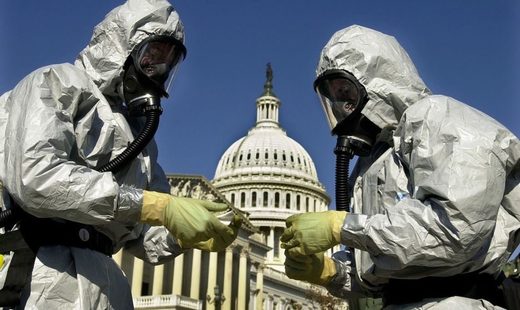Tidligere på året meddelte japanske medier, at USA's regering har testet afgrødeødelæggende biovåben på Okinawa, så vel som i Taiwan og på amerikansk grund igennem 1960'erne og de tidlige 1970'ere. På trods af Konventionen om biologiske og toksiske våben, der blev underskrevet af mange stater og trådte i kraft i 1975 er mange lande, så som USA og Israel, fortsat med at operere biovåbenprogrammer, stod der i rapporten fra China National Defence.
Avisen hævdede, at USA's militær udvikler genetiske våben i et hemmeligt R&D projekt, hvor påståede deltagere hævder at gener fra kinesere, europæere, kaukasere og arabere alle indgår i forskningen. Et stort antal af ikke militære organisationer siges også at deltage i USA's genkrigsprojekt i håb om at udvikle medicin og fødevarer, der vil mutere den genetiske struktur i visse grupper mennesker, tilføjede avisen.
Kommentar: Delvist oversat af Sott.net fra US may be collecting Chinese genes for bioweapons: Military report
The report said that the US has already developed actual genetic weapons, such as implanting an African and Middle Eastern virus in ordinary winemaking yeast to pass on various diseases. Russia is also said to be using genetic engineering methods to research a new anthrax-type toxin variant that is resistant to antibiotics, while Israel is rumored to be developing a genetic weapon that is deadly to Arabs but benign to people of Jewish descent.
These countries are investing heavily in gene research because genetically-engineered bioweapons are not only efficient but also cost-effective in their ability to kill masses of people, the report said. It might take, for example, just US$50 million to build a storage for genetic weapons, but it could take more than US$5 billion to store nuclear weapons, the paper said. If Ebola or the HIV virus could be weaponized, they could potentially wipe out humanity, the report added.
There are also numerous ways in which genetic weapons could be utilized. Bacteria or virus-carrying insects and microorganisms could be spread manually by hand, on planes or in bombs, and could be placed in rivers, cities or on transport infrastructure to ensure rapid effect.
Genetic weapons are more difficult to detect, and often only the engineers of the weapon have the keys to its genetic "code," making it difficult for enemies to develop an antidote or vaccine in time. Compared to ordinary weapons, genetically engineered bioweapons can cause much greater psychological damage to the people targeted, the report said.
With the rapid advancement of biotechnology spurring the rising threat of genetic weapons, China National Defense said it is important to actively pursue the spirit of the the UN Universal Declaration on the Human Genome and Human Rights issued in 1997, best known for its statement against human cloning and abuse of human genome against human dignity. On the other hand, scientists should be proactive in gene research that is beneficial to improving human health and immunity to better protect against genetic weapons.




Kommentar: Since this report surfaced then disappeared down the memory hole, it has emerged that the Americans are considering the same thing for Russians: a 'Russian-specific virus' that will kill them and leave Americans victorious in the 'Great Game'.
Putin claims someone is harvesting Russian bio samples for obscure purposes - US Air Force admits to collecting genetic data for "research"